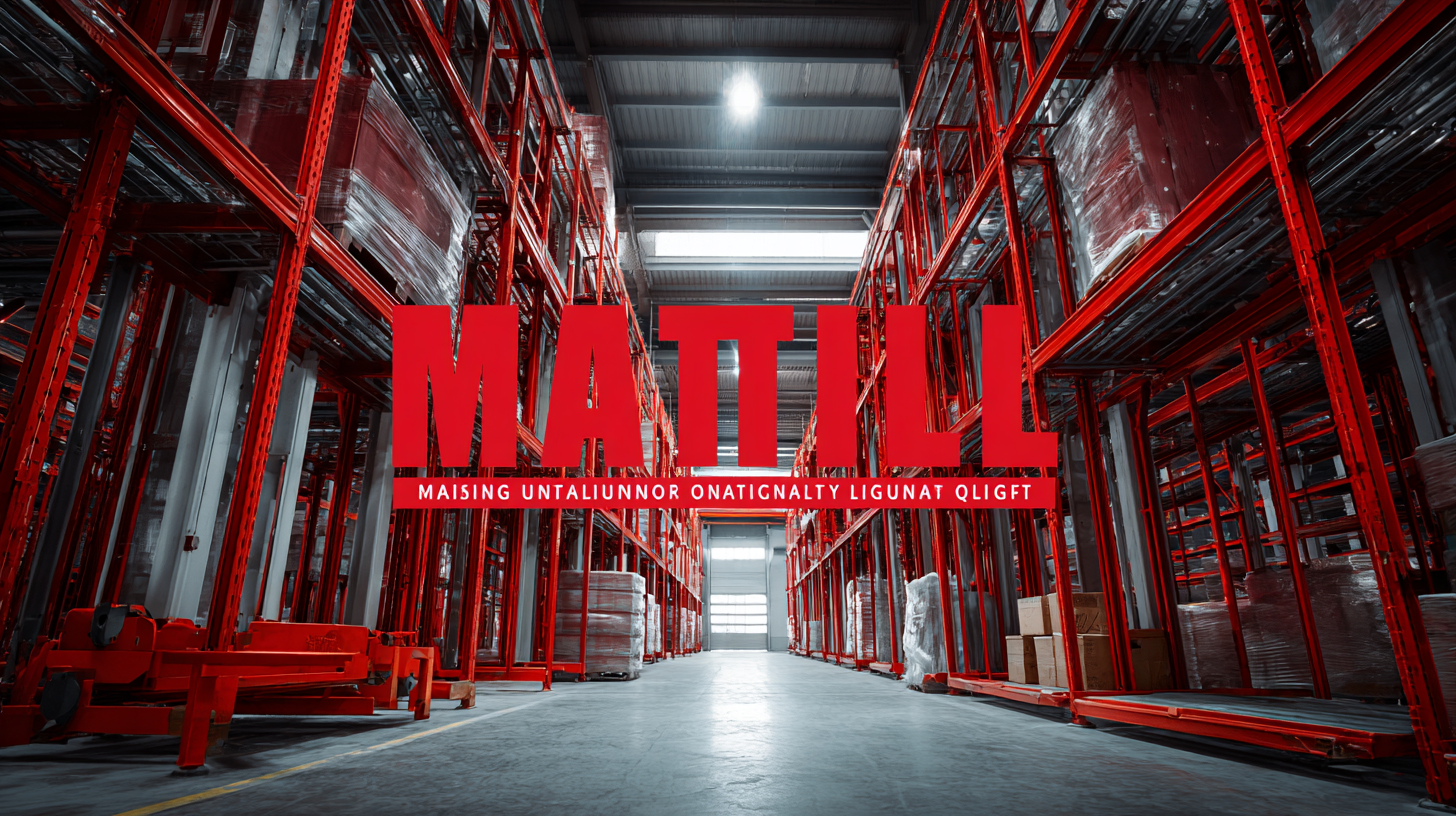China's Smart Manufacturing: The Global Leader in Quality Material Handling Lifts
 China's emergence as a global leader in smart manufacturing has significantly transformed the landscape of material handling, particularly in the realm of Material Handling Lifts. According to a report by Market Research Future, the material handling equipment market is expected to surpass USD 200 billion by 2025, with Asia-Pacific leading this growth trajectory. The emphasis on efficiency, automation, and innovative technology has compelled manufacturers to adapt their product offerings, catering to diverse industries ranging from automotive to e-commerce.
China's emergence as a global leader in smart manufacturing has significantly transformed the landscape of material handling, particularly in the realm of Material Handling Lifts. According to a report by Market Research Future, the material handling equipment market is expected to surpass USD 200 billion by 2025, with Asia-Pacific leading this growth trajectory. The emphasis on efficiency, automation, and innovative technology has compelled manufacturers to adapt their product offerings, catering to diverse industries ranging from automotive to e-commerce.
Within this context, understanding the characteristics and applications of different types of Material Handling Lifts is essential for optimizing operational productivity and safety. As China continues to spearhead advancements in quality and sustainability, its approaches to material handling are not only setting benchmarks but also influencing global standards, highlighting the vital role of these lifts in modern supply chain management.
China's Journey to Smart Manufacturing: Embracing Digital Transformation
China's transformation into a global leader in smart manufacturing is marked by its commitment to embracing digital advancements. As industries integrate cutting-edge technologies, such as the Internet of Things (IoT) and artificial intelligence (AI), they enhance operational efficiency and ensure superior quality in material handling lifts. This digital transformation is not merely an upgrade; it represents a profound shift in how Chinese manufacturers conceptualize production, focusing on automation and data-driven decision-making.
The emphasis on smart manufacturing is evident across various sectors in China. Manufacturers are leveraging big data analytics to optimize supply chains, streamline workflows, and reduce waste. This innovative approach has positioned Chinese companies at the forefront of quality material handling solutions, setting the standard for global competitors. By incorporating smart technologies, businesses are not only bolstering their productivity but also improving safety and reducing environmental impacts, ultimately contributing to a more sustainable manufacturing landscape.

Innovative Technologies Driving Quality in Material Handling Lifts
 China is rapidly emerging as a global leader in the field of smart manufacturing, particularly in the realm of material handling lifts. The integration of innovative technologies, such as the Internet of Things (IoT), artificial intelligence, and automation, is transforming the way these essential tools are designed and utilized. As manufacturing processes become more complex, the demand for efficient and high-quality material handling solutions has surged, driving Chinese manufacturers to focus on precision engineering and advanced production techniques.
China is rapidly emerging as a global leader in the field of smart manufacturing, particularly in the realm of material handling lifts. The integration of innovative technologies, such as the Internet of Things (IoT), artificial intelligence, and automation, is transforming the way these essential tools are designed and utilized. As manufacturing processes become more complex, the demand for efficient and high-quality material handling solutions has surged, driving Chinese manufacturers to focus on precision engineering and advanced production techniques.
The emphasis on quality in material handling lifts not only enhances operational efficiency but also aligns with the principles of Industry 4.0. This new manufacturing paradigm utilizes data analytics and real-time monitoring to optimize workflows, ensuring that lifts are not only robust but also tailored to specific industry needs. As these technologies evolve, the interplay between innovation and quality becomes increasingly crucial, enabling manufacturers to meet the rising global standards while simultaneously addressing sustainability concerns through improved lifecycle assessments. This commitment to quality and innovation positions China at the forefront of the smart manufacturing revolution.
The Role of Automation in Enhancing Efficiency and Safety
In today's manufacturing landscape, automation plays a pivotal role in enhancing the efficiency and safety of material handling operations. According to a report by the International Federation of Robotics, global sales of industrial robots reached approximately 384,000 units in 2020, marking a substantial increase of 12% from the previous year. This surge underscores the growing reliance on automated systems in factories, reflecting a broader trend where precision and speed are paramount.
Automated material handling lifts, specifically designed to address labor-intensive tasks, can significantly reduce the risk of workplace injuries, which account for millions of lost workdays annually.
Furthermore, advancements in artificial intelligence and machine learning are leading to smart lifts that adapt to their operational environment. A study published by Markets and Markets indicates that the automated material handling equipment market is projected to reach $48.4 billion by 2026, growing at a CAGR of 10.5% from 2021. This growth is driven by the need for increased efficiency, as automated systems optimize workflow by ensuring timely delivery of materials while minimizing human error. Such technological integration not only streamlines operations but also contributes to a safer work environment, reaffirming China's position as a global leader in smart manufacturing solutions.
Sustainability Practices in China's Material Handling Industry
China's material handling industry is increasingly focusing on sustainability practices, ensuring that operations meet both economic and environmental standards. As the construction sector grapples with effective waste management, it has become apparent that the health of construction sustainability heavily hinges on how waste is handled during both construction and demolition phases. By employing advanced waste management practices, companies can minimize their waste footprint while also utilizing recyclable materials, setting a benchmark for global standards.
Tips for companies in the material handling industry include investing in technologies that promote durability and reuse of equipment. This not only reduces waste but also leads to long-term cost savings. Additionally, embracing sustainable supply chain management can enhance resilience against disruptions, which have been prevalent in recent years. Companies should prioritize a circular economy by implementing strategies that allow for the remanufacturing of components, thus fostering a more sustainable business model.
Moreover, collaboration within the industry can lead to improved waste paper management, critical for reducing dependency on raw materials. Elevating sustainability practices will not only benefit companies economically but will also significantly contribute to the global effort of reducing environmental impact. As China leads in smart manufacturing, the integration of green practices in material handling sets a profound example for industries worldwide.
China's Smart Manufacturing: The Global Leader in Quality Material Handling Lifts - Sustainability Practices in China's Material Handling Industry
| Material Handling Lift Type | Load Capacity (kg) | Energy Efficiency (%) | Sustainability Certification | Recyclable Material Used (%) |
|---|---|---|---|---|
| Electric Forklift | 3000 | 85 | ISO 14001 | 90 |
| Pallet Jack | 1500 | 80 | CE Mark | 85 |
| Automated Guided Vehicle (AGV) | 2000 | 90 | ISO 9001 | 95 |
| Overhead Crane | 5000 | 75 | FSC Certified | 80 |
Global Impact: How China's Standards Set the Bar for Quality Worldwide
China’s ambitious drive in smart manufacturing is not just about technological advancements; it is setting the global standard for quality in material handling lifts. As the world becomes increasingly connected, China's influence on international quality benchmarks is profound. The country’s push for top-tier manufacturing—reflected in its “2035 Standards”—highlights its desire to lead in global standard-setting. This initiative encourages innovation and efficiency, thereby raising the bar for competitors worldwide.
In the context of heightened U.S.-China tensions, the focus on quality has further implications. A partial technological decoupling could restrict collaborations, compelling both nations to enhance their standards independently. Companies aiming to survive in this competitive landscape must prioritize quality and adherence to international standards, which increasingly now take cues from China's policies.
**Tips:** Invest in quality management training for your team to stay ahead of new standards. Monitor emerging technological trends in China to adapt your strategies accordingly. Collaborate with organizations that prioritize high-quality developments to bolster your operations and align with global benchmarks.
China's Smart Manufacturing: Quality Material Handling Lifts
This bar chart illustrates the improvement in quality standards for material handling lifts in China over recent years, showcasing China's leadership in smart manufacturing.

